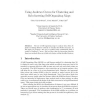194 search results - page 8 / 39 » Self-organizing maps and symbolic data |
ESANN
2008
13 years 9 months ago
2008
Ant-based clustering is a nature-inspired technique whereas stochastic agents perform the task of clustering high-dimensional data. This paper analyzes the popular technique of Lum...
NPL
2002
13 years 7 months ago
2002
Recently, feature maps have been applied to various problem domains.The success of some of these applications critically depends on whether feature maps are topologically ordered. ...
KDD
2000
ACM
13 years 11 months ago
2000
ACM
This paper presents the MicroNOMAD Discovering Tool. Its main characteristic is both to provide an user with emergent analyses of a multimedia database content and with querying a...
IJCNN
2000
IEEE
14 years 9 days ago
2000
IEEE
In this paper we present the growing hierarchical self-organizing map. This dynamically growing neural network model evolves into a hierarchical structure according to the requirem...
ESANN
2004
13 years 9 months ago
2004
Abstract. The use of self-organizing maps to analyze data often depends on finding effective methods to visualize the SOM's structure. In this paper we propose a new way to pe...

